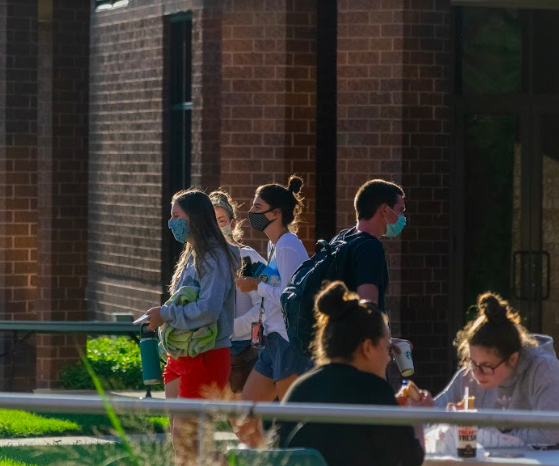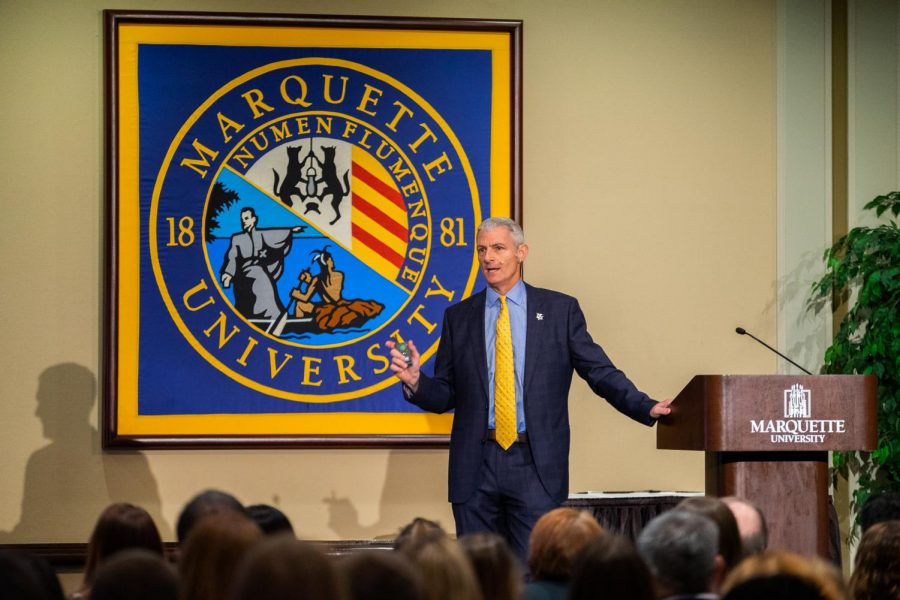Chris Stolarski, associate director for university communication, tested positive for COVID-19 Nov. 11, 2020. He first developed COVID-19-like symptoms in early November, as he said that it began with a tickle in his throat that quickly developed into a persistent fever. A polymerase chain reaction test confirmed that it was COVID-19. PCR tests identify the presence of a virus if/when one is infected at the time of the test.
Stolarski was on medical leave for about three months due to complications COVID-19 but has since returned and resumed most of his duties.
For the first few days of his diagnosis, he said that his symptoms were pretty mild. However, on day six he developed respiratory symptoms — a persistent cough and shortness of breath.
“Over the next 36 hours, my respiration depleted, sending my blood-oxygen saturation well below 90%, which is dangerously low,” Stolarski said in an email. “On Friday, November 13, my wife called an ambulance. I was taken to the emergency department and then admitted to the intensive care unit at St. Luke’s South Shore.”
Stolarski said that he credits Timothy Cigelske, director of integrated content, with saving his life, as he brought him an at-home pulse oximeter that initially told him how dangerously low his oxygen saturation was.
According to the Minnesota Department of Health, a pulse oximeter may help someone diagnosed with COVID-19 monitor their health and to alert them if they need medical care. Many patients with COVID-19 have low oxygen levels in their blood which can be an early sign that they need medical treatment. A normal level of oxygen is typically 95% or higher, so the oximeter displays the percentage of oxygen in someone’s blood. https://www.health.state.mn.us/diseases/coronavirus/pulseoximeter.html
When Stolarski arrived to the intensive care unit, he said that he was initially put on 60 liters of oxygen per minute. Over the next several days, the medical staff was able to bring his oxygen down to 50 liters. Stolarski said in an email that, “I was incredibly lucky to avoid being put on a ventilator.”
The Minnesota Department of Health states that COVID-19 may inflame one’s airways which would drown their lungs in fluids. Being put on a ventilator mechanically pumps oxygen into your body, and the ventilator could potentially breathe out for you too. When hooked up to a ventilator some patients may not be able to eat or drink normally, so they would need to get their nutrients through an IV. https://www.webmd.com/lung/coronavirus-ventilators#:~:text=COVID%2D19%20can%20inflame,it%20on%20your%20own.
Stolarski stayed in the ICU for 19 days before transferring to a regular hospital room on the COVID-19 floor. His stay there lasted 26 days.
With no visitors allowed in the hospital, Stolarski said that his stay was haunting, extremely isolating and lonely. He said that since he was bedridden, not able to breathe on his own and unable to move by himself which left him psychologically paralyzed. He said that there were days he thought he may be stuck like that forever.
Fortunately, Stolarski has made immense progress since December. He said that he has not needed to be put on oxygen in months, and he can get around on his own more easily. He said that he still gets tired and winded more easily than he had pre-pandemic, but he can now walk up to a mile and a half on his own, “a feat that was unthinkable just months ago,” Stolarski said in an email.
However, Stolarski does have some lingering effects from the virus as well as often experiencing nightmares and trouble sleeping.
Many co-workers and colleagues were left shocked and cheered him on through his recovery.
“Chris has always been someone who brings his convictions and a deep caring about others to his work. He’s part of the fabric of what we do at Marquette” Cigelske said in an email, “When he got sick, it sent shock waves through the Marquette community because of how many people he’s touched. He brought others together as part of his cheering section, and we’re still cheering for him as he continues his recovery.”
Lynn Griffith, senior director of university communication, works with Stolarski and also helped support him throughout his journey while making his life at work easier.
“My goal is to provide as much grace as possible from a work perspective while Chris deals with the physical and mental side effects of COVID-19” Griffith said.
Stolarski said that he cannot change to understand the value of having a cheering section when you are in the fight of your life. He said that his colleagues were an important factor in his recovery, as “they joined seamlessly my wife, family and other friends in the most important cheering section I’ll ever have,” Stolarski said in an email.
Now Stolarski is an advocate for COVID-19 patients, survivors and vaccinations. He said he is happy to lend an ear to whomever needs advice, whether they are recovering at home or in the hospital. “The effect this had on me is profound. I was incredibly cautious, and the virus still got me. It really shows how insidious and indiscriminate it is, and it really underscores how vulnerable we are” Stolarski said in an email.
This story was written by Julia Abuzzahab. She can be reached at julianna.abuzzahab@marquette.edu











